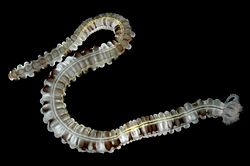Characteristics
These sea cucumbers are vagile holothurians with an elongated shape (up to 3 meters for Synapta maculata ), worm or snake-like. Their shape is adapted for burrowing through the sediment, sometimes in a fashion similar to earthworms. Their mouth is surrounded with 10-25 pinnate or peltate tentacles. The absence of tube feet gives the order its name, Apodida meaning without feet : they move by crawling on the sediment, hence they need flat bottoms with few current. Members of this order have a circum-oral ring and tentacles, but do not have tube feet or radial canals. They also lack the complex respiratory trees found in other sea cucumbers, and respire and excrete nitrogenous waste through their skin. [1]
The ossicles, minute calcareous plates embedded in the skin and characteristic of each species, can include wheel and anchor shapes. [2]
This page is based on this
Wikipedia article Text is available under the
CC BY-SA 4.0 license; additional terms may apply.
Images, videos and audio are available under their respective licenses.







